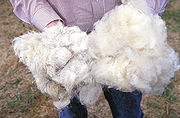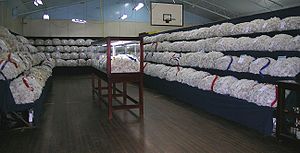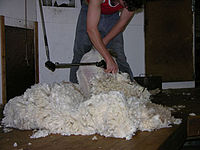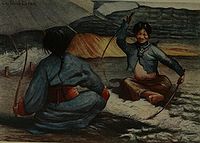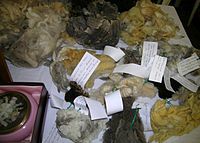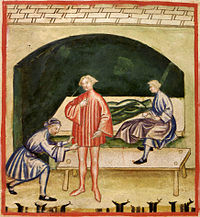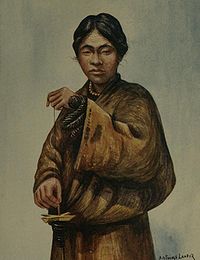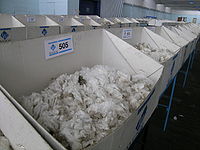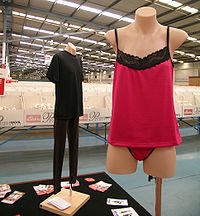
Wool
Did you know...
This wikipedia selection has been chosen by volunteers helping SOS Children from Wikipedia for this Wikipedia Selection for schools. To compare sponsorship charities this is the best sponsorship link.
Wool is the fibre derived from the specialized skin cells, called follicles, of animals in the Caprinae family, principally sheep, but the hair of certain species of other mammals such as goats, llamas, and rabbits may also be called wool. Wool has several qualities that distinguish it from hair or fur: it is crimped; it has a different texture or handle; it is elastic; and it grows in staples (clusters).
Characteristics

Wool's scaling and crimp make it easier to spin the fleece. They help the individual fibers attach to each other so that they stay together. Because of the crimp, wool fabrics have a greater bulk than other textiles and retain air, which causes the product to retain heat. Insulation also works both ways; Bedouins and Tuaregs use wool clothes to keep the heat out.
The amount of crimp corresponds to the thickness of the wool fibers. A fine wool like Merino may have up to a hundred crimps per inch, while the coarser wools like karakul may have as few as one to two crimps per inch. Hair, by contrast, has little if any scale and no crimp, and little ability to bind into yarn. On sheep, the hair part of the fleece is called kemp. The relative amounts of kemp to wool vary from breed to breed, and make some fleeces more desirable for spinning, felting, or carding into batts for quilts or other insulating products.
Wool possesses much greater ability to return to its natural length after being stretched than any artificial fiber. In water or steam, wool can stretch to about twice its length without breaking. Because of elasticity, woollen garments may be stretched or crushed without losing their shape. Also, this fibre felts readily, by heat, moisture, and pressure being applied during the manufacturing processes.
Wool fibers are hygroscopic. This means wool has the power to readily absorb and give off moisture. It can absorb moisture up to one-third of its own weight. Synthetic fibers can only absorb 2-3 percent of moisture before they begin to feel wet. Additionally, wool absorbs sound and reduces noise level considerably like many other fabrics. Wool is generally a creamy white colour, although some breeds of sheep produce natural colors such as black, brown, silver, and random mixes.
Wool is harder to ignite than most synthetic and cotton fibers used in equivalent products (higher ignition temperature); it has lower rate of flame spread, low heat release, and low heat of combustion; doesn't melt or drip; forms a char which is insulating and self-extinguishes; and contributes less to toxic gases and smoke than other flooring products when used in carpets. Wool carpets are specified for high safety environments such as trains and aircraft. Wool is usually specified for garments for fire-fighters, soldiers, and others in occupations where they are exposed to the likelihood of fire.
Wool is static resistant as the retention of moisture within the fabric prevents a build up of static electricity. Woollen garments are much less likely to spark or cling to the body. The use of woollen car seat covers or carpets reduces the risk of a shock when a person touches a grounded object.
Processing
Wool straight off a sheep contains a high level of grease which contains valuable lanolin, as well as dirt, dead skin, sweat residue, and vegetable matter. This state is known as "grease wool" or "wool in the grease". Before the wool can be used for commercial purposes it must be scoured, or cleaned. Scouring may be as simple as a bath in warm water, or a complicated industrial process using detergent and alkali. In commercial wool, vegetable matter is often removed by the chemical carbonization. In less processed wools, vegetable matter may be removed by hand, and some of the lanolin left intact through use of gentler detergents. This semi-grease wool can be worked into yarn and knitted into particularly water-resistant mittens or sweaters, such as those of the Aran Island fishermen. Lanolin removed from wool is widely used in cosmetics products such as hand creams.
After shearing, the wool is separated into five main categories: fleece (which makes up the vast bulk), broken, pieces, bellies, and locks. The latter four are pressed into wool packs and sold separately. The quality of fleece is determined by a technique known as wool classing, whereby a qualified wool classer groups wools of similar gradings together to maximise the return for the farmer or sheep owner. Prior to Australian auctions, all Merino fleece wool is objectively measured for micron, yield (including the amount of vegetable matter), staple length, staple strength, and sometimes colour and comfort factor.
Quality
The quality of wool is determined by the following factors, fiber diameter, yield, staple length, color, and staple strength. Fibre diameter is the single most important wool characteristic determining quality and price.
Merino wool is typically 3-5 inches in length and is very fine (between 12-24 microns). The finest and most valuable wool comes from Merino hoggets. Wool taken from sheep produced for meat is typically more coarse, and has fibers are 1.5 to 6 inches in length. Damage or breaks in the wool can occur if the sheep is stressed while it is growing its fleece, resulting in a thin spot where the fleece is likely to break.
Wool is also separated into grades based on the measurement of the wool's diameter in microns. These grades may vary depending on the breed or purpose of the wool. For example:
- < 17.5 - Ultrafine Merino
- 17.6-18.5 - Superfine Merino
- < 19.5 - Fine Merino
- 19.6-20.5 - Fine medium Merino
- 20.6-22.5 - Medium Merino
- 22.6 < - Strong Merino
or
- < 24.5 - Fine
- 24.5–31.4 - Medium
- 31.5-35.4 - Fine crossbred
- 35.5 < - coarse crossbred
In general, anything finer than 25 microns can be used for garments, while coarser grades are used for outerwear or rugs. The finer the wool, the softer it will be, while coarser grades are more durable and less prone to pilling.
The finest Australian and New Zealand Merino wools are known as 1PP which is the industry benchmark of excellence for Merino wool that is 16.9 micron and finer. This style represents the top level of fineness, character, colour, and style as determined on the basis of a series of parameters in accordance with the original dictates of British Wool as applied today by the Australian Wool Exchange (AWEX) Council. Only a few dozen of the millions of bales auctioned every year can be classified and marked 1PP.
History
As the raw material has been readily available since the widespread domestication of sheep - and of goats, another major provider of wool - the use of felted or woven wool for clothing and other fabrics characterizes some of the earliest civilizations. Prior to invention of shears - probably in the Iron Age - the wool was plucked out by hand or by bronze combs. The oldest known European woollen textile, ca. 1500 BCE, was preserved in a Danish bog .
In Roman times, wool, linen, and leather clothed the European population; the cotton of India was a curiosity that only naturalists had heard of; and silk, imported along the Silk Road from China, was an extravagant luxury. Pliny the Elder records in his Natural History that the reputation for producing the finest wool was enjoyed by Tarentum, where selective breeding had produced sheep with a superior fleece, but which required special care.
In medieval times, as trade connections expanded, the Champagne fairs revolved around the production of woollen cloth in small centers such as Provins; the network that the sequence of annual fairs developed meant that the woollens of Provins might find their way to Naples, Sicily, Cyprus, Majorca, Spain, and even Constantinople (Braudel, 316). The wool trade developed into serious business, the generator of capital. In the thirteenth century, the wool trade was the economic engine of the Low Countries and of Central Italy; by the end of the following century Italy predominated, though in the 16th century Italian production turned to silk (Braudel p 312). Both pre-industries were based on English raw wool exports - rivaled only by the sheepwalks of Castile, developed from the fifteenth century - which were a significant source of income to the English crown, which from 1275 imposed an export tax on wool called the "Great Custom". The importance of wool to the English economy can be shown by the fact that since the 14th Century, the presiding officer of the House of Lords has sat on the " Woolsack", a chair stuffed with wool.
Economies of scale were instituted in the Cistercian houses, which had accumulated great tracts of land during the twelfth and early thirteenth centuries, when land prices were low and labour still scarce. Raw wool was baled and shipped from North Sea ports to the textile cities of Flanders, notably Ypres and Ghent, where it was dyed and worked up as cloth. At the time of the Black Death, English textile industries accounted for about 10% of English wool production (Cantor 2001, 64); the English textile trade grew during the fifteenth century, to the point where export of wool was discouraged. Over the centuries, various British laws controlled the wool trade or required the use of wool even in burials. The smuggling of wool out of the country, known as owling, was at one time punishable by the cutting off of a hand. After the Restoration, fine English woollens began to compete with silks in the international market, partly aided by the Navigation Acts; in 1699 English crown forbade its American colonies to trade wool with anyone but England herself.
A great deal of the value of woollen textiles was in the dyeing and finishing of the woven product. In each of the centers of the textile trade, the manufacturing process came to be subdivided into a collection of trades, overseen by an entrepreneur in a system called by the English the "putting-out" system, or "cottage industry", and the Verlagssystem by the Germans. In this system of producing woollen cloth, until recently perpetuated in the production of Harris tweeds, the entrepreneur provides the raw materials and an advance, the remainder being paid upon delivery of the product. Written contracts bound the artisans to specified terms. Fernand Braudel traces the appearance of the system in the thirteenth-century economic boom, quoting a document of 1275 (Braudel, 317) The system effectively by-passed the guilds' restrictions.
Before the flowering of the Renaissance, the Medici and other great banking houses of Florence had built their wealth and banking system on their textile industry based on wool, overseen by the Arte della Lana, the wool guild: wool textile interests guided Florentine policies. Francesco Datini, the "merchant of Prato", established in 1383 an Arte della Lana for that small Tuscan city. The sheepwalks of Castile shaped the landscape and the fortunes of the meseta that lies in the heart of the Iberian peninsula; in the sixteenth century, a unified Spain allowed export of Merino lambs only with royal permission. The German wool market - based on sheep of Spanish origin - did not overtake British wool until comparatively late. Australia's colonial economy was based on sheep raising, and the Australian wool trade eventually overtook that of the Germans by 1845, furnishing wool for Bradford, which developed as the heart of industrialized woollens production.

- Fernand Braudel, 1982. The Wheels of Commerce, vol 2 of Civilization and Capitalism (New York:Harper & Row)
Due to decreasing demand with increased use of synthetic fibers, wool production is much less than what it was in the past. The collapse in the price of wool began in late 1966 with a 40% drop; with occasional interruptions, the price has tended down. The result has been sharply reduced production and movement of resources into production of other commodities, in the case of sheep growers, to production of meat.
In December 2004, a bale of the world's finest wool, averaging 11.8 micron, sold for 300,000 cents per kilogram at auction in Melbourne, Victoria. This fleece wool tested with an average yield of 74.5%, 68mm long, and had 40 newtons per kilotex strength. The result was $AUD279,000 for the bale. The finest bale of wool ever auctioned sold for a seasonal record of 269,000 cents per kilo during June, 2008. This bale was produced by the Hillcreston Pinehill Partnership and measured 11.6 microns, 72.1% yield and had a 43 Newtons per kilotex strength measurement. The bale realised $247,480 and was exported to India.
Production
Global wool production is approximately 1.3 million tonnes per annum of which 60% goes into apparel. Australia is the leading producer of wool which is mostly from Merino sheep. New Zealand is the second largest producer of wool, but is the largest producer of crossbred wool. China is the third largest producer of wool. Breeds such as Lincoln, Romney, Tukidale, Drysdale and Elliotdale produce coarser fibers, and wool off these sheep is usually used for making carpets.
In the United States, Texas, New Mexico and Colorado also have large commercial sheep flocks and their mainstay is the Rambouillet (or French Merino). There is also a thriving home-flock contingent of small-scale farmers who raise small hobby flocks of specialty sheep for the hand spinning market. These small-scale farmers may raise any type of sheep they wish, so the selection of fleeces is quite wide.
Global wool clip 2004/2005
- Australia: 25% of global wool clip (475 million kg greasy, 2004/2005)
- China: 18%
- New Zealand: 11%
- Argentina: 3%
- Turkey: 2%
- Iran: 2%
- United Kingdom: 2%
- India: 2%
- Sudan: 2%
- South Africa: 1%
- United States: 0.77%
Keeping with the times, organic wool is becoming more and more popular. This wool is very limited in supply and much of it comes from New Zealand and Australia. Organic wool is becoming easier to find in clothing and other products, though these products often carry a higher price. Wool is environmentally preferable (as compared to petroleum-based Nylon or Polypropylene) as a material for carpets as well, in particular when combined with a natural binding and the use of formaldehyde-free glues.
Animal rights groups have noted issues with the production of wool, such as Mulesing.
Wool Marketing
Australia
The dominant form of marketing for about 85 per cent of Australian wool is sale by open cry auction. Sale by Sample is a method in which a mechanical claw takes a sample from each bale in a line or lot of wool. These grab samples are bulked, objectively measured, and a sample of not less than 4 kg is displayed in a box for the buyer to examine. The Australian Wool Exchange (AWEX) conducts sales primarily in Sydney, Melbourne, Newcastle, and Fremantle. There are about eighty brokers and agents throughout Australia.
About 15 percent of wool is sold by private treaty on-farm or to local wool-handling facilities. This option gives wool growers benefit from reduced transport, warehousing, and selling costs. This method is preferred for small lots or mixed butts in order to make savings on reclassing and testing.
Sale by tender can achieve considerable cost savings on wool clips large enough to make it worthwhile for potential buyers to submit tenders. Some marketing firms sell wool on a consignment basis, obtaining a fixed percentage as commission.
Forward selling: Some buyers will offer a secure price for forward delivery of wool based on estimated measurements or the results of previous clips. Prices are quoted at current market rates and are locked in for the season. Premiums and discounts are added to cover variations in micron, yield, tensile strength, etc., which are confirmed by actual test results when available.
Another method of selling wool includes sales direct to wool mills.
Other countries
The British Wool Marketing Board operates a central marketing system for UK fleece wool with the aim of achieving the best possible net returns for farmers.
Less than half of New Zealand's wool is now sold at auction, but many farmers (around 45%) now sell wool directly to private buyers and end-users.
United States sheep producers market wool with private or cooperative wool warehouses, but wool pools are common in many states. In some cases, wool is pooled in a local market area but sold through a wool warehouse. Wool offered with objective measurement test results is preferred. Imported apparel wool and carpet wool goes directly to central markets where it is handled by the large merchants and manufacturers.
Uses
In addition to clothing, wool has been used for blankets, horse rugs, saddle cloths, carpeting, felt, wool insulation (also see links) and upholstery. Wool felt covers piano hammers, and it is used to absorb odours and noise in heavy machinery and stereo speakers. Ancient Greeks lined their helmets with felt, and Roman legionnaires used breastplates made of wool felt.
Wool has also been traditionally used to cover cloth diapers. Wool fiber exteriors are hydrophobic (repel water) and the interior of the wool fibre is hygroscopic (attracts water; this makes a wool garment able to cover a wet diaper while inhibiting wicking so outer garments remain dry. Wool felted and treated with lanolin is water resistant, air permeable, and slightly antibacterial, so it resists the buildup of odour. Some modern cloth diapers use felted wool fabric for covers, and there are several modern commercial knitting patterns for wool diaper covers.
Yarns
Virgin wool is wool spun for the first time, as contrasted with shoddy.
Shoddy or recycled wool is made by cutting or tearing apart existing wool fabric and respinning the resulting fibers. As this process makes the wool fibers shorter, the remanufactured fabric is inferior to the original. The recycled wool may be mixed with raw wool, wool noil, or another fibre such as cotton to increase the average fibre length. Such yarns are typically used as weft yarns with a cotton warp. This process was invented in the Heavy Woollen District of West Yorkshire and created a micro-economy in this area for many years.
Ragg is a sturdy wool fibre made into yarn and used in many rugged applications like gloves.
Worsted is a strong, long-staple, combed wool yarn with a hard surface.
Woollen is a soft, short- staple, carded wool yarn typically used for knitting. In traditional weaving, woollen weft yarn (for softness and warmth) is frequently combined with a worsted warp yarn for strength on the loom.
Events
Being one of the biggest buyers of Merino wool, Ermenegildo Zegna has encouraged, supported, and rewarded the efforts of the Australian wool producers since 1963 in the production of finer and softer wools. In 1963, the first Ermenegildo Zegna Perpetual Trophy was presented in Tasmania for growers of "Superfine skirted Merino fleece." In 1980, a national award, the Ermenegildo Zegna Trophy for Extrafine Wool Production, was launched. In 2004, this award became known as the Ermenegildo Zegna Unprotected Wool Trophy. In 1998, an Ermenegildo Zegna Protected Wool Trophy was launched for fleece from sheep coated for around nine months of the year.
In 2002, the Ermenegildo Zegna Vellus Aureum Trophy was launched for wool that is 13.9 micron and finer. Wool from Australia, New Zealand, Argentina, and South Africa may enter, and a winner is named from each country. In April 2008, New Zealand won the coveted Ermenegildo Zegna Vellus Aureum Trophy for the first time with a fleece which measured 10.8 microns. This contest awards the winning fleece weight with the same weight in gold as a prize, hence the name.
Since 2000, Loro Piana has awarded a cup for the world’s finest bale of wool which produces just enough fabric for 50 tailor-made suits. The prize is awarded to an Australian or New Zealand wool grower who produces the year's finest bale.
The New England Merino Field days which display local studs, wool, and sheep are held during January, every two years (in even numbered years) around the Walcha, New South Wales district. The Annual Wool Fashion Awards, which showcase the use of Merino wool by fashion designers, are hosted by the city of Armidale, New South Wales in March each year. This event encourages young and established fashion designers to display their talents. During each May, Armidale hosts the annual New England Wool Expo to display wool fashions, handicrafts, demonstrations, shearing competitions, yard dog trials, and more.
In July, the annual Australian Sheep and Wool Show is held in Bendigo, Victoria. This is the largest sheep and wool show in the world, with goats and alpacas as well as woolcraft competitions and displays, fleece competitions, sheepdog trials, shearing, and wool handling. The largest competition in the world for objectively-measured fleeces is the Australian Fleece Competition, which is held annually at Bendigo. In 2008, there were 475 entries from all states of Australia with first and second prizes going to Northern Tablelands, New South Wales fleeces.

